The history of the formation and development of AI
This article by INVIAI provides a detailed overview of the history of AI’s formation and development, from its early conceptual ideas, through the challenging “AI winters,” to the deep learning revolution and the explosive wave of generative AI in the 2020s.
Artificial Intelligence (AI) today has become a familiar part of modern life, appearing in every field from business to healthcare. However, few realize that the history of AI development began in the mid-20th century and went through many ups and downs before achieving the explosive breakthroughs we see today.
This article by INVIAI offers a detailed look at the history of AI's formation and development, from the initial early ideas, through the difficult "AI winters," to the deep learning revolution and the generative AI wave that exploded in the 2020s.
- 1. 1950s: The Beginning of Artificial Intelligence
- 2. 1960s: Early Progress
- 3. 1970s: Challenges and the First "AI Winter"
- 4. 1980s: Expert Systems – Rise and Decline
- 5. 1990s: AI Returns to Practicality
- 6. 2000s: Machine Learning and the Big Data Era
- 7. 2010s: The Deep Learning Revolution
- 8. 2020s: The Generative AI Boom and New Trends
- 9. Conclusion: AI's Journey and Future Prospects
1950s: The Beginning of Artificial Intelligence
The 1950s are considered the official starting point of the AI field. In 1950, mathematician Alan Turing published the paper "Computing Machinery and Intelligence," in which he proposed a famous test to evaluate a machine's ability to think – later known as the Turing Test. This milestone introduced the idea that computers could "think" like humans, laying the theoretical foundation for AI.
Every aspect of learning or any other feature of intelligence can in principle be so precisely described that a machine can be made to simulate it.
— Dartmouth Conference Declaration, 1956
Early AI Programs (1951)
Machine Learning Pioneer (1955)
Logic Theorist (1956)
Key Technical Developments
- Lisp Programming Language (1958) – John McCarthy invented Lisp, designed specifically for AI development
- Perceptron (1958) – Frank Rosenblatt introduced the first artificial neural network model capable of learning from data
- "Machine Learning" Term (1959) – Arthur Samuel first used this term to describe how computers could learn beyond their original programming
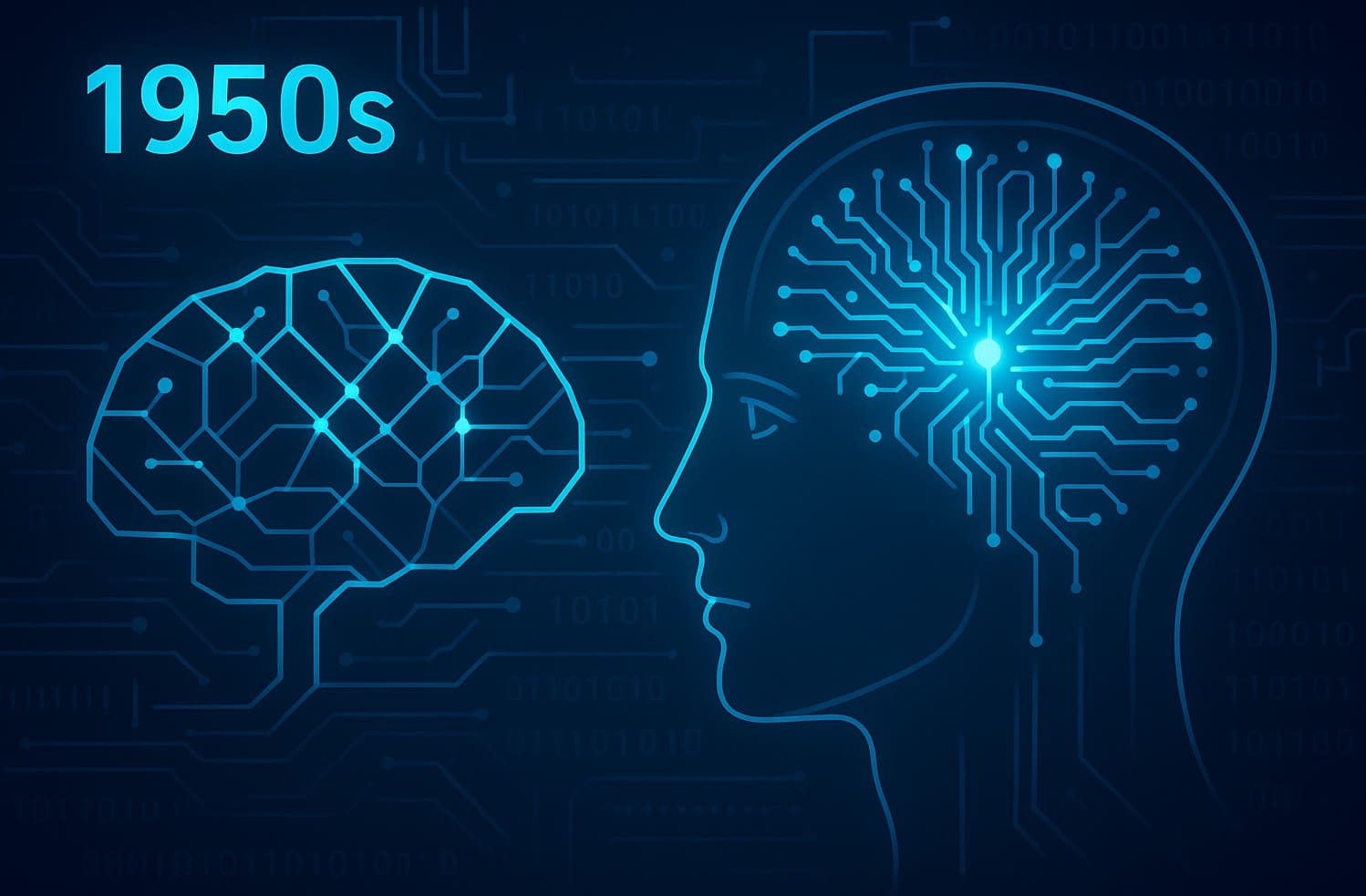
These developments reflected strong optimism: pioneers believed that within a few decades, machines could achieve human-like intelligence.
1960s: Early Progress
Entering the 1960s, AI continued to develop with many notable projects and inventions. AI laboratories were established at prestigious universities (MIT, Stanford, Carnegie Mellon), attracting research interest and funding. Computers became more powerful, allowing experimentation with more complex AI ideas than in the previous decade.
ELIZA (1966)
Joseph Weizenbaum at MIT created the first chatbot program simulating conversation in the style of a psychotherapist.
- Based on keyword recognition and scripted responses
- Many users believed ELIZA truly "understood" them
- Paved the way for modern chatbots
Shakey Robot (1966-1972)
Stanford Research Institute developed the first mobile robot capable of self-awareness and action planning.
- Integrated computer vision, NLP, and planning
- Could navigate environments autonomously
- Foundation for modern AI robotics
Breakthrough Innovations
DENDRAL (1965)
Prolog Language (1972)
AAAI Founded
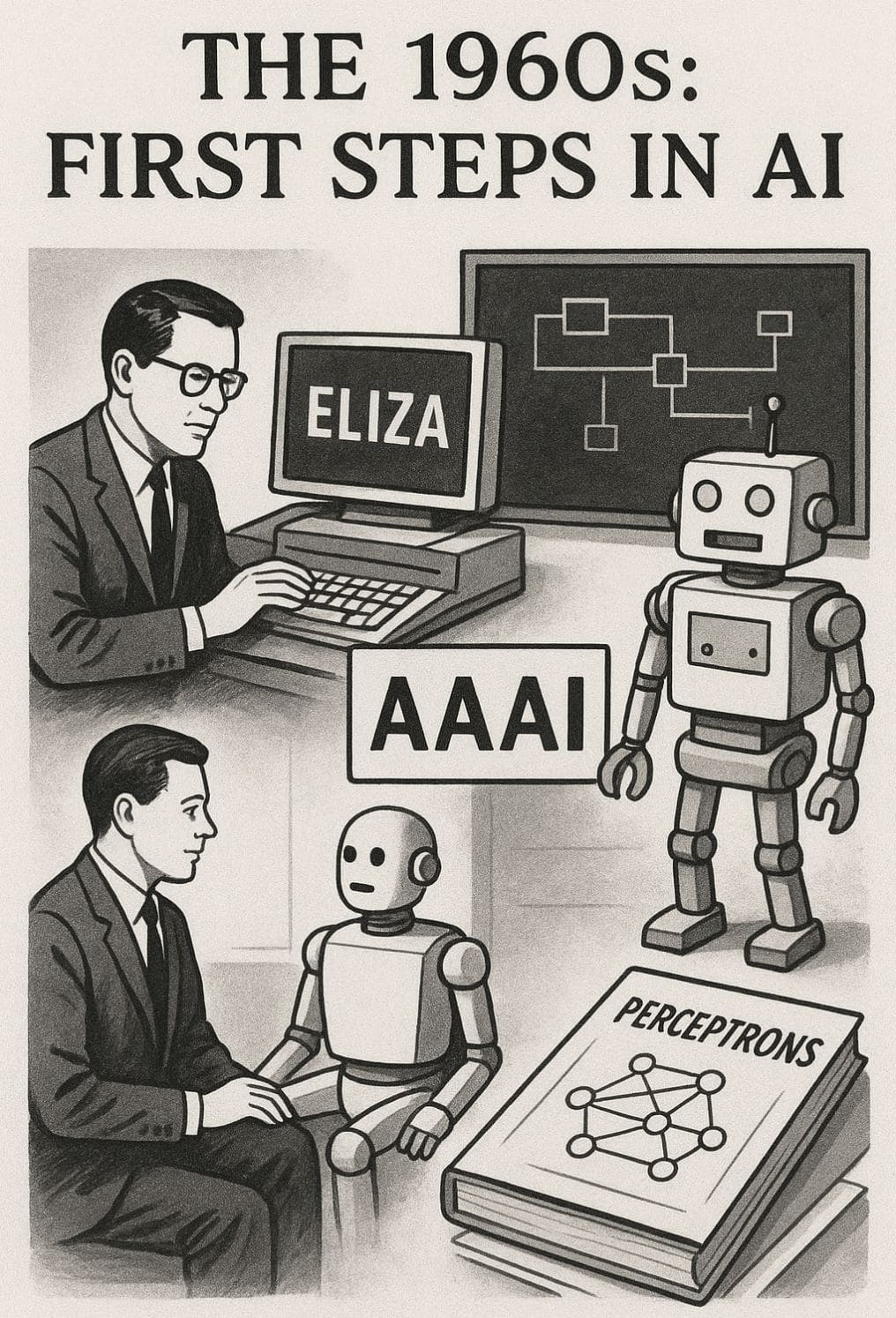
1970s: Challenges and the First "AI Winter"
In the 1970s, AI faced real-world challenges: many high expectations from the previous decade were unmet due to limitations in computing power, data, and scientific understanding. As a result, confidence and funding for AI sharply declined by the mid-1970s – a period later called the first "AI winter".
High Expectations
- Optimistic predictions about AI capabilities
- Strong government and academic funding
- Ambitious research projects
- Growing AI community
AI Winter Reality
- Severe funding cuts from DARPA and UK government
- Research nearly frozen
- Scientists shifting to related fields
- Public skepticism about AI potential
Bright Spots Despite Difficulties
MYCIN (1974)
Stanford Cart (1979)
Prolog Applications
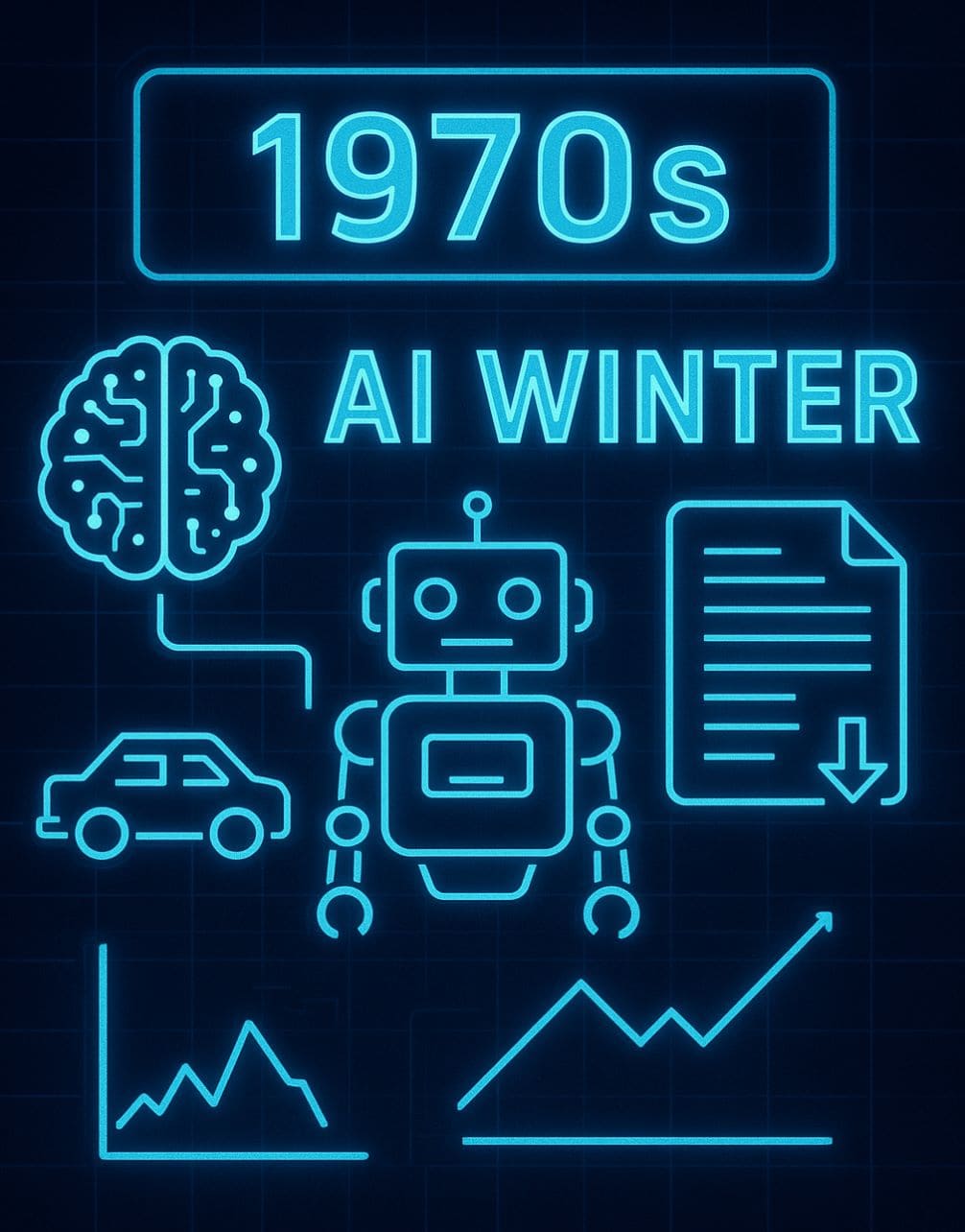
This period reminded researchers that artificial intelligence is far more complex than initially thought, requiring fundamentally new approaches beyond simple reasoning models.
1980s: Expert Systems – Rise and Decline
By the early 1980s, AI entered a renaissance period driven by the commercial success of expert systems and renewed investment interest from governments and businesses. Computers became more powerful, and the community believed that AI ideas could gradually be realized in narrow domains.
Major Government Initiatives
Japan's Fifth Generation Project (1982)
US DARPA Response
Neural Networks Revival
Amid the expert systems boom, the field of artificial neural networks quietly revived. In 1986, researcher Geoffrey Hinton and colleagues published the Backpropagation algorithm – an effective method for training multi-layer neural networks.
Backpropagation Algorithm (1986)
This breakthrough overcame the limitations highlighted in the 1969 Perceptrons book and sparked a second wave of neural network research.
- Enabled training of multi-layer neural networks
- Laid groundwork for future deep learning
- Young researchers like Yann LeCun and Yoshua Bengio joined the movement
- Successfully developed handwriting recognition models by late 1980s
AI Renaissance
- Commercial expert systems success
- Lisp machines market boom
- Major government investments
- Growing business adoption
Second AI Winter
- Expert systems revealed limitations
- Lisp machine market collapsed (1987)
- Sharp investment cuts
- Many AI companies closed
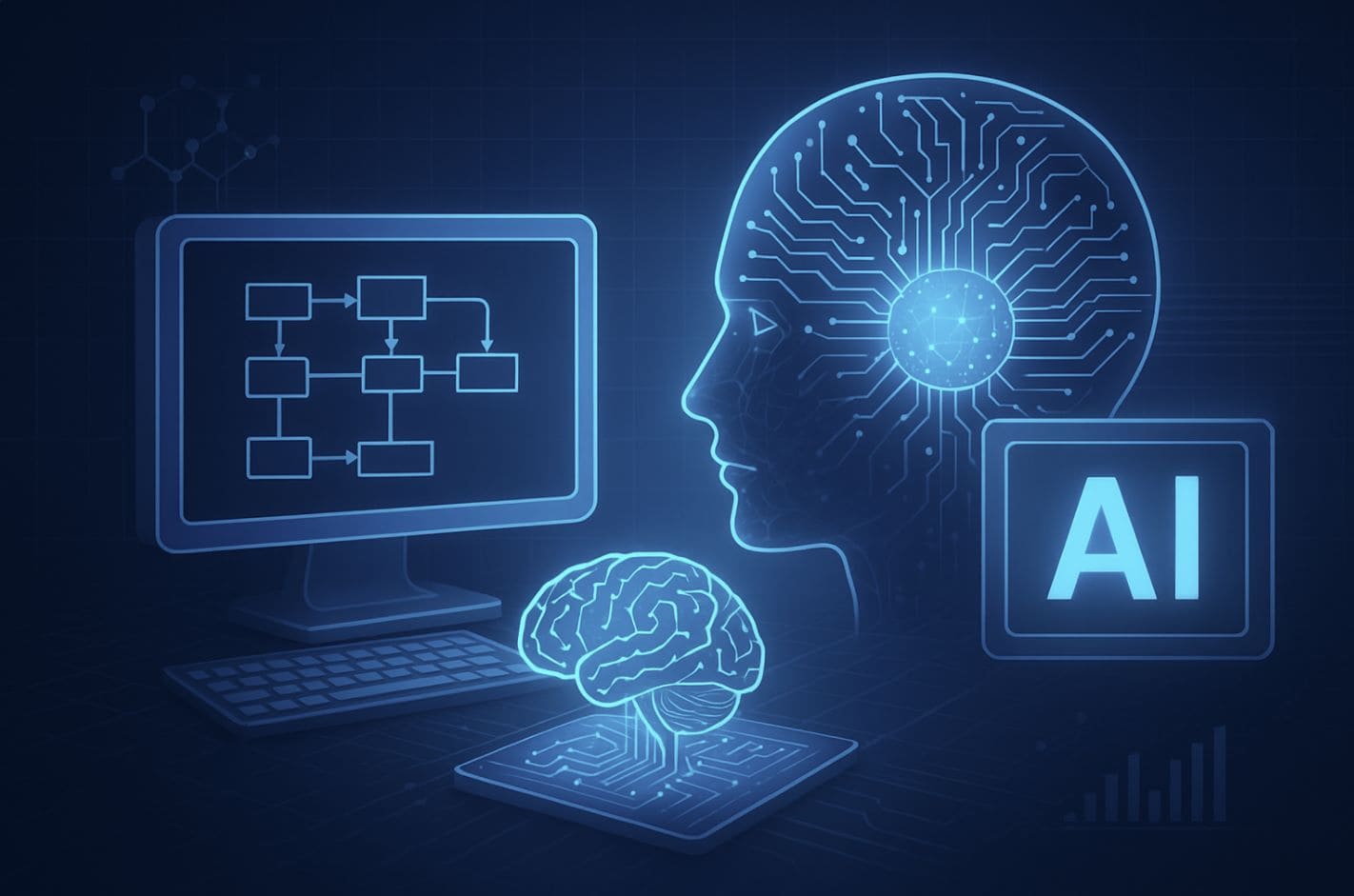
1990s: AI Returns to Practicality
After the late 1980s AI winter, confidence in AI gradually recovered in the 1990s thanks to a series of practical advances. Instead of focusing on ambitious strong AI, researchers concentrated on weak AI – applying AI techniques to specific problems where they began to show impressive results.
Major Achievements Across Domains
Chinook (1994)
Speech Recognition
Handwriting Recognition
Machine Vision
Machine Translation
Spam Filters
The Rise of Data-Driven AI
The late 1990s saw the Internet boom, generating massive digital data. Techniques like data mining and machine learning algorithms were used to:
- Analyze web data and optimize search engines
- Personalize content recommendations
- Filter email spam automatically
- Provide product recommendations in e-commerce
- Improve software performance by learning from user data
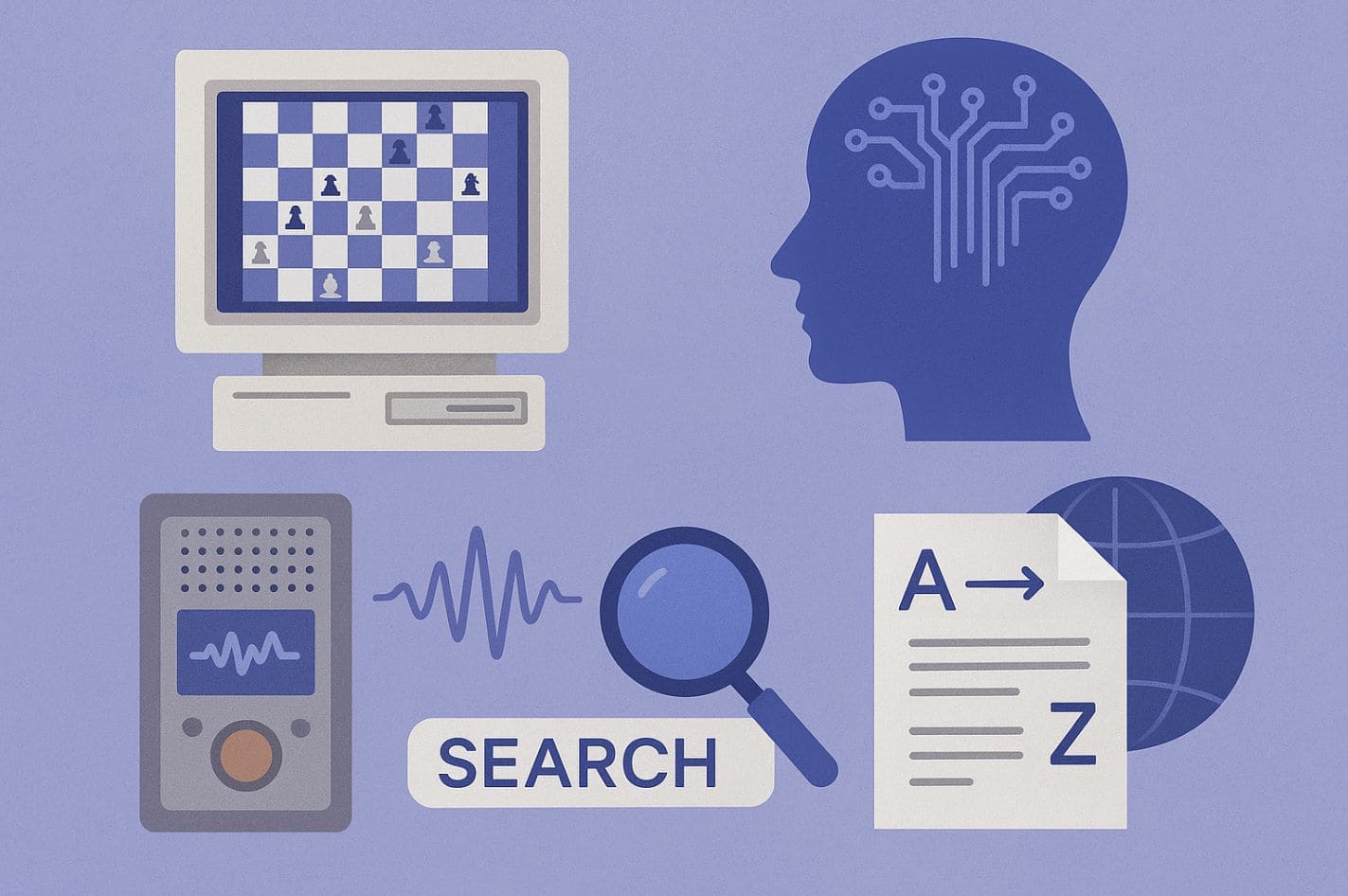
The 1990s was a period when AI quietly but steadily entered everyday life. Instead of grand claims of human-like intelligence, developers focused on solving specialized problems, laying important foundations in data and algorithms for the explosive growth in the next decade.
2000s: Machine Learning and the Big Data Era
Entering the 21st century, AI transformed dramatically thanks to the Internet and the big data era. The 2000s witnessed the explosion of personal computers, the Internet, and sensor devices, generating enormous amounts of data. Machine learning became the main tool to exploit this "data goldmine."
Data is the new oil – the more data available, the more accurate AI algorithms could learn.
— Popular tech industry saying, 2000s
ImageNet: The Foundation for Deep Learning
ImageNet Project (2006-2009)
Professor Fei-Fei Li at Stanford initiated a massive database of over 14 million labeled images.
- Became the standard dataset for computer vision algorithms
- Annual ImageNet Challenge from 2010 onwards
- Provided sufficient data for training complex deep models
- Enabled the historic AI breakthrough in 2012
Notable Application Milestones
Stanford Self-Driving Car
The Stanford Cart "Stanley" won the DARPA Grand Challenge, completing a 212 km desert autonomous vehicle race in 6 hours 53 minutes, ushering in a new era for self-driving cars.
Google Voice Search
Voice search app enabled on iPhone, marking the beginning of mainstream voice-controlled AI assistants.
Apple Siri Launch
Voice-controlled virtual assistant integrated into iPhone, marking AI's first large-scale public adoption.
IBM Watson Victory
Supercomputer Watson defeated two champions on Jeopardy!, demonstrating AI's strength in natural language processing and information retrieval.
AI Enters Business
Amazon
Netflix
YouTube
Enterprise AI
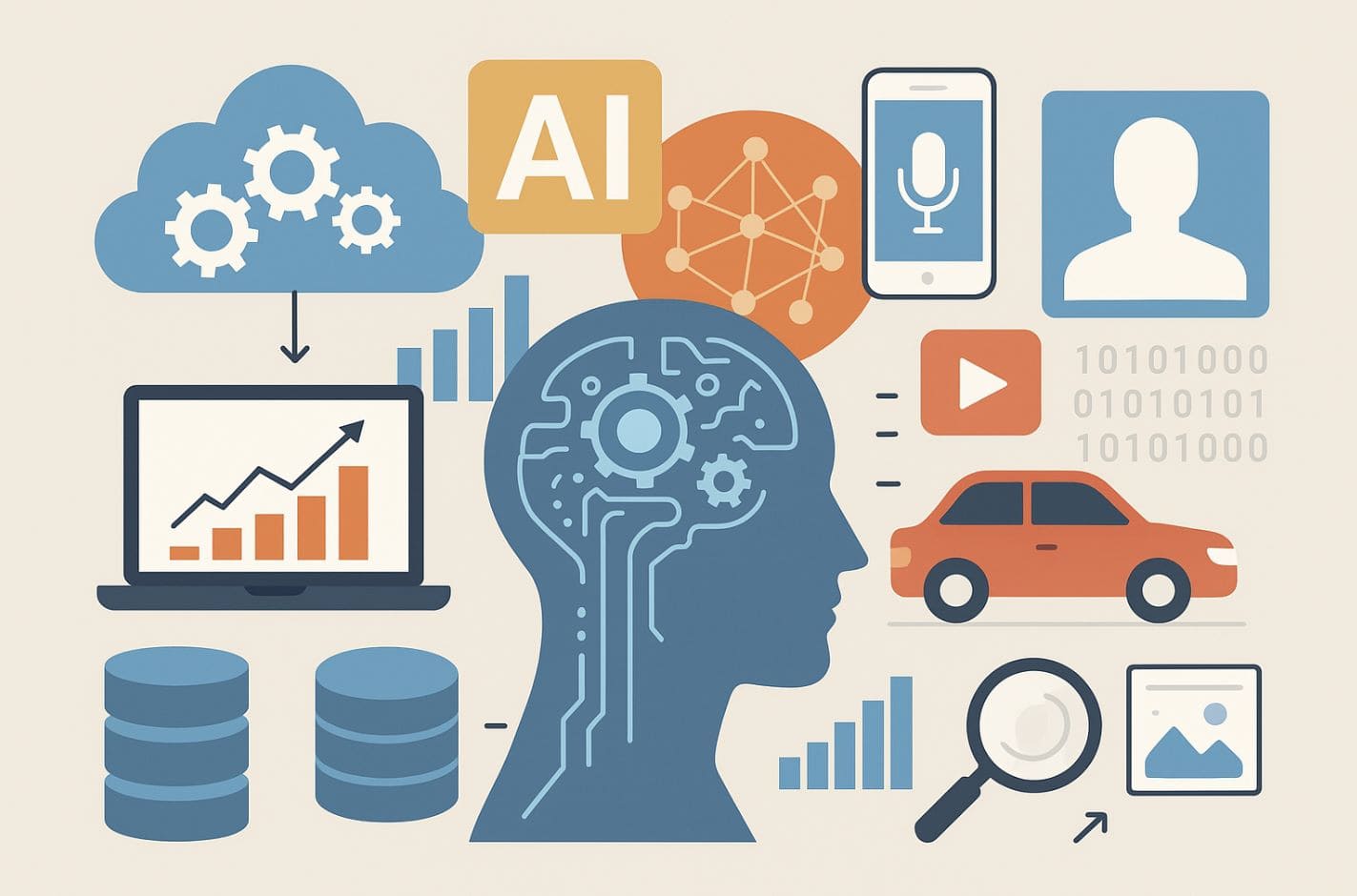
The 2000s laid the groundwork for AI's explosive growth. Big data, powerful hardware, and improved algorithms were ready, just waiting for the right moment to ignite a new AI revolution.
2010s: The Deep Learning Revolution
If there is one period when AI truly "took off", it was the 2010s. Building on the data and hardware foundations of the previous decade, artificial intelligence entered the deep learning era – multi-layer neural network models achieved breakthrough results, breaking all records across a wide range of AI tasks.
The AlexNet Revolution
Traditional Methods
- Hand-crafted feature extraction
- Limited accuracy in image recognition
- Slow progress in computer vision
- Multiple competing approaches
Deep Learning Era
- Automatic feature learning
- Error rates cut in half
- Rapid advancement across all AI fields
- Deep learning became dominant approach
Deep Learning Spreads Across Domains
Computer Vision
Speech Processing
Machine Translation
AlphaGo: AI Surpasses Human Intuition
AlphaGo Victory (March 2016)
DeepMind's AlphaGo defeated world Go champion Lee Sedol 4-1, confirming that AI could surpass humans in domains requiring intuition and experience.
- Go is far more complex than chess
- Combined deep learning and Monte Carlo Tree Search
- Learned from millions of human games and self-play
- AlphaGo Zero (2017) learned entirely from scratch and defeated previous version 100-0
The Transformer Revolution (2017)
In 2017, a breakthrough in natural language processing emerged: the Transformer architecture. Google researchers published the paper "Attention Is All You Need", proposing a self-attention mechanism that revolutionized language AI.
Transformer (2017)
Self-attention mechanism without sequential processing
BERT (2018)
Google's model for contextual understanding
GPT (2018)
OpenAI's generative pre-trained model
GPT-2 (2019)
1.5B parameters, human-like text generation
The Rise of Generative AI
GANs (2014)
Style Transfer
VAE
GPT-2 Text Generation
AI in Everyday Life
- Smartphone cameras with automatic face recognition
- Virtual assistants in smart speakers (Alexa, Google Home)
- Content recommendations on social media
- Advanced self-driving car systems
- Real-time language translation
- Personalized learning platforms
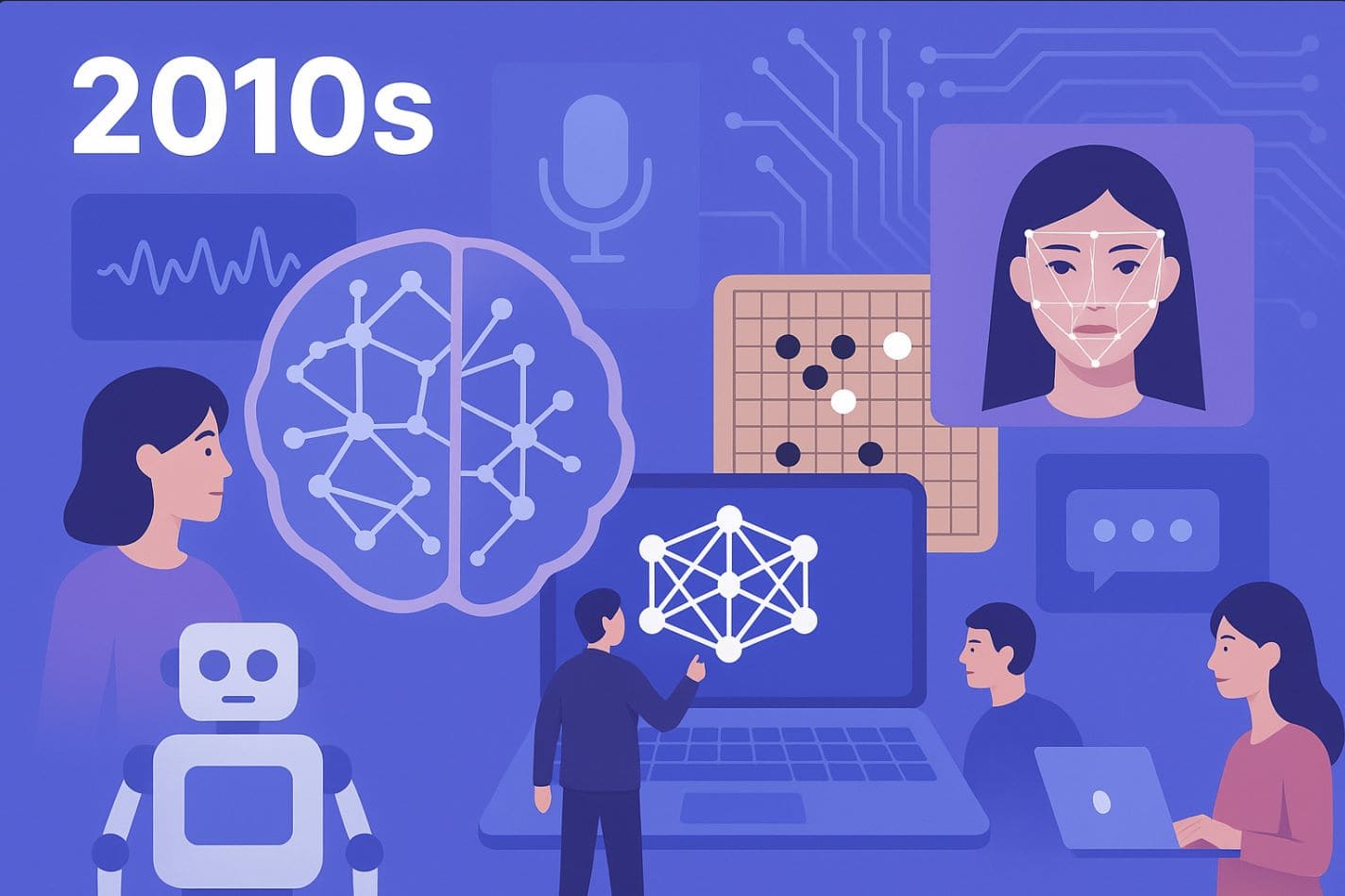
AI is the new electricity – a foundational technology transforming every industry.
— Andrew Ng, AI Pioneer
2020s: The Generative AI Boom and New Trends
In just the first few years of the 2020s, AI has exploded at an unprecedented pace, mainly driven by the rise of generative AI and large language models (LLMs). These systems have enabled AI to reach hundreds of millions of users directly, sparking a wave of creative applications and widespread social discussions.
The Era of Large Language Models
GPT-3 Launch
OpenAI introduced GPT-3 with 175 billion parameters, demonstrating unprecedented language fluency in writing, answering questions, composing poetry, and coding.
ChatGPT Revolution
In November 2022, ChatGPT launched and reached 1 million users in 5 days and 100 million users in 2 months – the fastest-growing consumer app in history.
The AI Race Begins
Microsoft integrated GPT-4 into Bing, Google launched Bard chatbot, sparking intense competition among tech giants to develop and deploy generative AI.
Generative AI Beyond Text
DALL-E 2 (2022)
Midjourney
Stable Diffusion
Text-to-Speech
Video Generation
Music Generation
Ethical and Legal Challenges
Legal and Regulatory Challenges
- EU AI Act – World's first comprehensive AI regulation, banning "unacceptable risk" systems
- Copyright disputes – Training data usage and intellectual property rights
- US state laws – Limiting AI use in recruitment, finance, and elections
- Transparency requirements – Mandating disclosure of AI-generated content
Ethical and Social Concerns
- Deepfakes – Realistic fake content threatening trust and security
- Bias and fairness – AI systems perpetuating societal biases
- Job displacement – Automation impacting employment across industries
- Privacy concerns – Data collection and surveillance capabilities
AI Safety and Control
- Expert warnings – Over 1,000 tech leaders called for pause on training models larger than GPT-4
- Geoffrey Hinton's concerns – AI pioneer warned about dangers of AI escaping human control
- Alignment problem – Ensuring AI systems act according to human values
- Existential risks – Long-term concerns about superintelligent AI
AI Across Industries
Healthcare
AI transforming medical diagnosis and drug discovery.
- Medical imaging analysis and diagnosis support
- Drug discovery and development acceleration
- Personalized treatment recommendations
- Predictive healthcare analytics
Finance
Advanced risk analysis and fraud detection systems.
- Real-time fraud detection and prevention
- Algorithmic trading and market analysis
- Credit risk assessment
- Personalized financial advice
Education
Personalized learning and virtual tutoring.
- AI-powered virtual tutors
- Personalized learning content and pacing
- Automated grading and feedback
- Adaptive learning platforms
Transportation
Advanced autonomous vehicle systems.
- Self-driving car technology
- Traffic optimization and management
- Predictive maintenance
- Route optimization and logistics

Conclusion: AI's Journey and Future Prospects
From the 1950s to today, the history of AI development has been an astonishing journey – full of ambition, disappointment, and resurgence. From the small 1956 Dartmouth workshop that laid the foundation, AI has twice fallen into "AI winters" due to overhyped expectations, but each time rebounded stronger thanks to scientific and technological breakthroughs.
Today's AI Capabilities
- Present in almost every field
- Impressive performance in specific tasks
- Widespread commercial adoption
- Transforming industries globally
Path to Strong AI
- General artificial intelligence remains ahead
- Current models limited to trained tasks
- Safety and ethics require urgent attention
- Need for transparency and control
Future Prospects
The next chapter of AI promises to be extremely exciting. With current momentum, we can expect AI to penetrate even deeper into life:
AI Doctors
AI Lawyers
AI Companions
Neuromorphic Computing
Quantum AI
AGI Research
Key Lessons from AI History
- Avoid overhype – Set realistic expectations based on current capabilities
- Learn from failures – AI winters taught valuable lessons about sustainable development
- Prioritize safety – Develop AI with control, transparency, and ethical guidelines
- Focus on practical applications – Narrow AI solving specific problems delivers real value
- Embrace collaboration – Progress requires cooperation between researchers, industry, and policymakers
- Maintain human oversight – AI should augment, not replace, human judgment and values
Artificial intelligence has been, is, and will continue to be a testament to our ability to transcend limits. From primitive calculators that only computed, humans have taught machines to play games, drive cars, recognize the world, and even create art.
— Reflection on AI's Journey
AI today is like electricity or the Internet – a foundational technology infrastructure. Many experts are optimistic that AI will continue delivering leaps in productivity and quality of life if developed and managed responsibly. The future of AI is not predetermined – it will be shaped by the choices we make today about how to develop, deploy, and govern this transformative technology.


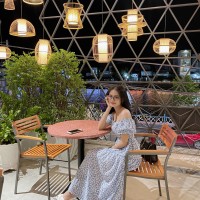

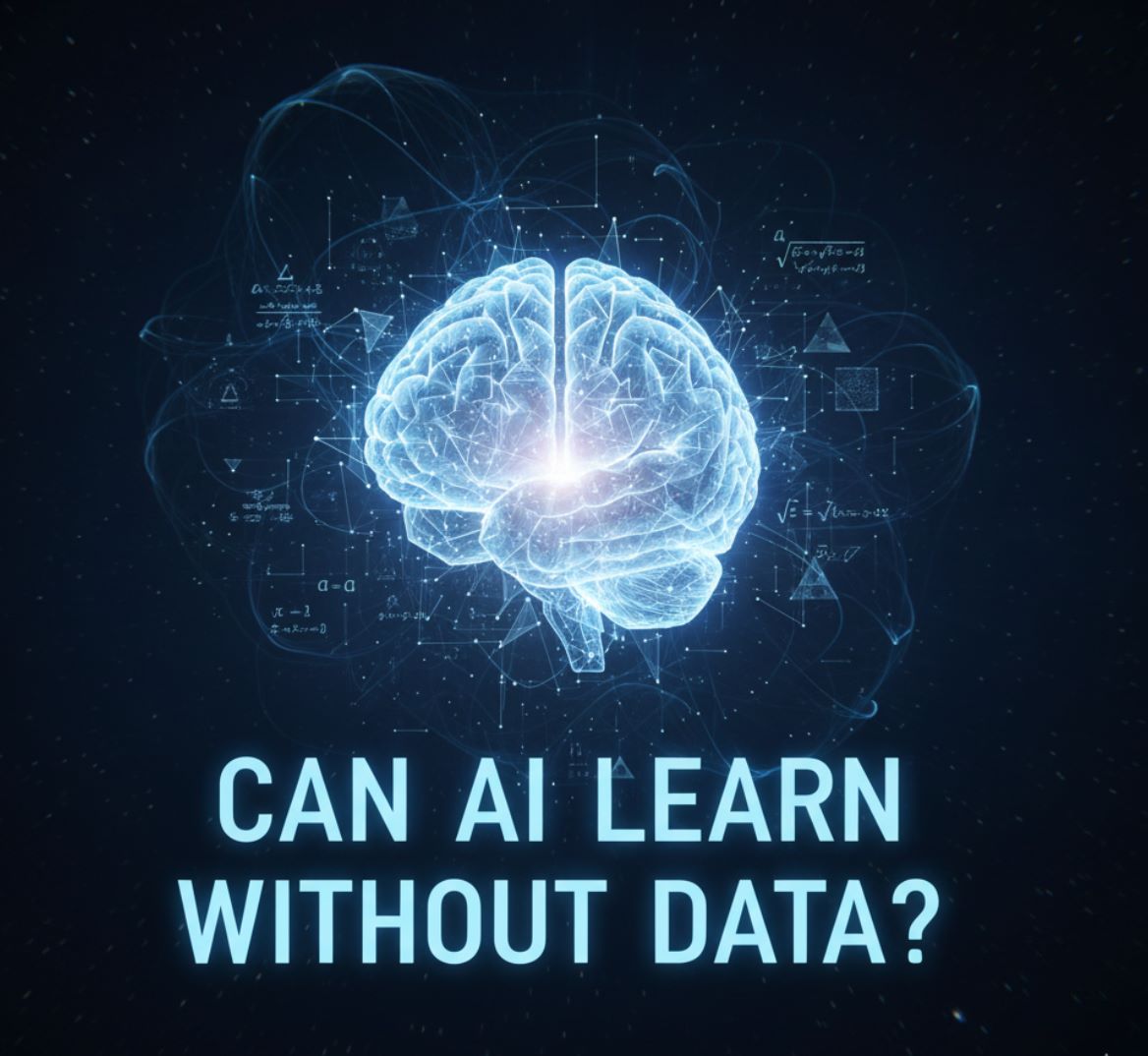
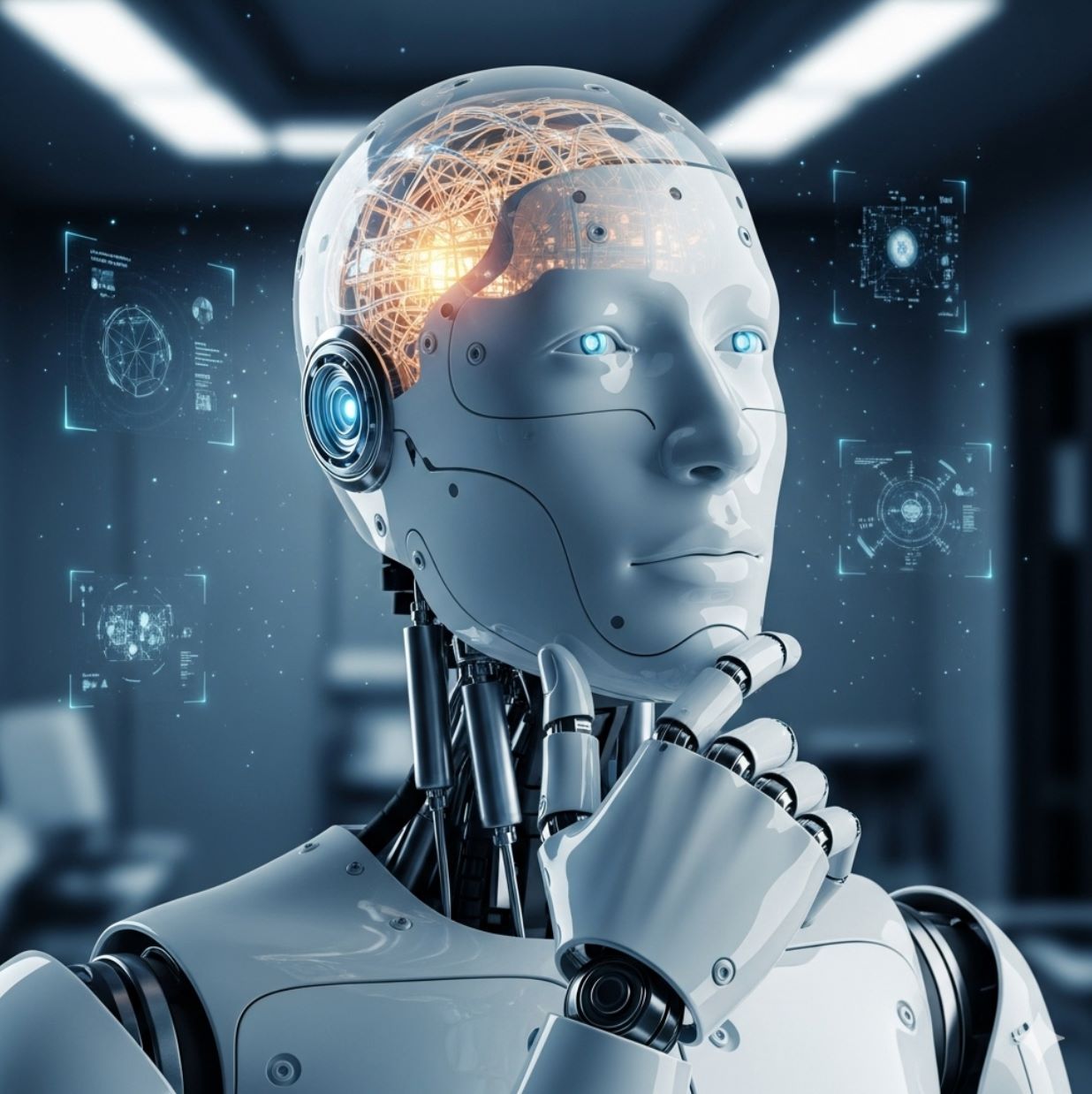
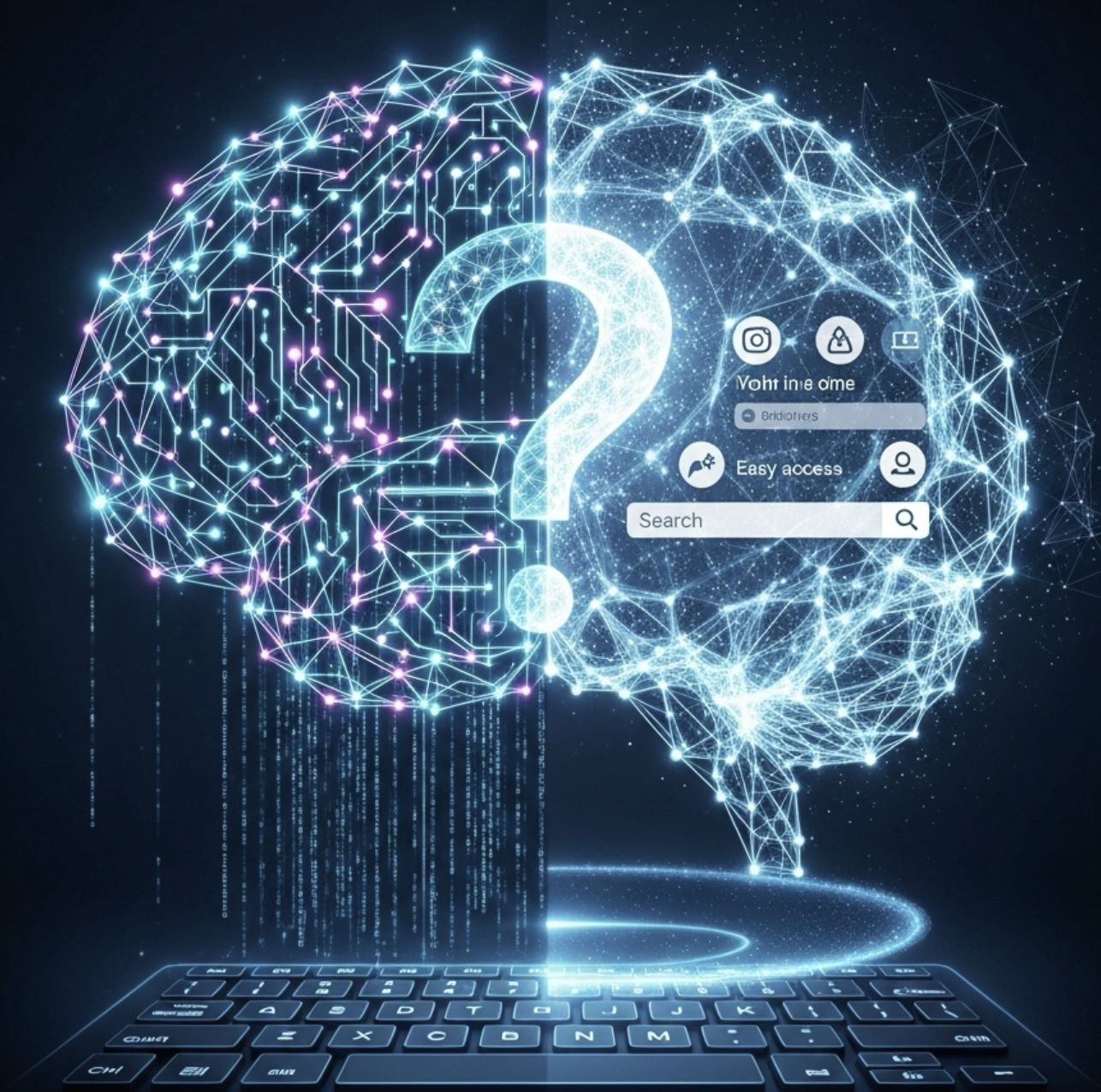
Comments 0
Leave a Comment
No comments yet. Be the first to comment!